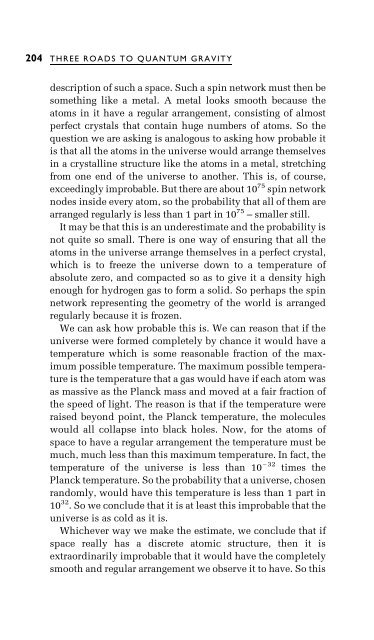Three Roads To Quantum Gravity
Three Roads To Quantum Gravity
Three Roads To Quantum Gravity
Create successful ePaper yourself
Turn your PDF publications into a flip-book with our unique Google optimized e-Paper software.
204 THREE ROADS TO QUANTUM GRAVITY<br />
description of such a space. Such a spin network must then be<br />
something like a metal. A metal looks smooth because the<br />
atoms in it have a regular arrangement, consisting of almost<br />
perfect crystals that contain huge numbers of atoms. So the<br />
question we are asking is analogous to asking how probable it<br />
is that all the atoms in the universe would arrange themselves<br />
in a crystalline structure like the atoms in a metal, stretching<br />
from one end of the universe to another. This is, of course,<br />
exceedingly improbable. But there are about 10 75 spin network<br />
nodes inside every atom, so the probability that all of them are<br />
arranged regularly is less than 1 part in 10 75 ± smaller still.<br />
It may be that this is an underestimate and the probability is<br />
not quite so small. There is one way of ensuring that all the<br />
atoms in the universe arrange themselves in a perfect crystal,<br />
which is to freeze the universe down to a temperature of<br />
absolute zero, and compacted so as to give it a density high<br />
enough for hydrogen gas to form a solid. So perhaps the spin<br />
network representing the geometry of the world is arranged<br />
regularly because it is frozen.<br />
We can ask how probable this is. We can reason that if the<br />
universe were formed completely by chance it would have a<br />
temperature which is some reasonable fraction of the maximum<br />
possible temperature. The maximum possible temperature<br />
is the temperature that a gas would have if each atom was<br />
as massive as the Planck mass and moved at a fair fraction of<br />
the speed of light. The reason is that if the temperature were<br />
raised beyond point, the Planck temperature, the molecules<br />
would all collapse into black holes. Now, for the atoms of<br />
space to have a regular arrangement the temperature must be<br />
much, much less than this maximum temperature. In fact, the<br />
temperature of the universe is less than 10 732 times the<br />
Planck temperature. So the probability that a universe, chosen<br />
randomly, would have this temperature is less than 1 part in<br />
10 32 . So we conclude that it is at least this improbable that the<br />
universe is as cold as it is.<br />
Whichever way we make the estimate, we conclude that if<br />
space really has a discrete atomic structure, then it is<br />
extraordinarily improbable that it would have the completely<br />
smooth and regular arrangement we observe it to have. So this



![arXiv:1001.0993v1 [hep-ph] 6 Jan 2010](https://img.yumpu.com/51282177/1/190x245/arxiv10010993v1-hep-ph-6-jan-2010.jpg?quality=85)


![arXiv:1008.3907v2 [astro-ph.CO] 1 Nov 2011](https://img.yumpu.com/48909562/1/190x245/arxiv10083907v2-astro-phco-1-nov-2011.jpg?quality=85)








![arXiv:1002.4928v1 [gr-qc] 26 Feb 2010](https://img.yumpu.com/41209516/1/190x245/arxiv10024928v1-gr-qc-26-feb-2010.jpg?quality=85)
![arXiv:1206.2653v1 [astro-ph.CO] 12 Jun 2012](https://img.yumpu.com/39510078/1/190x245/arxiv12062653v1-astro-phco-12-jun-2012.jpg?quality=85)
